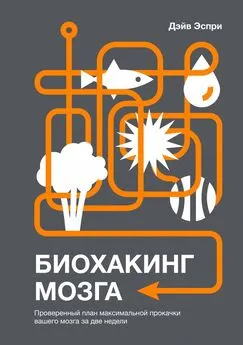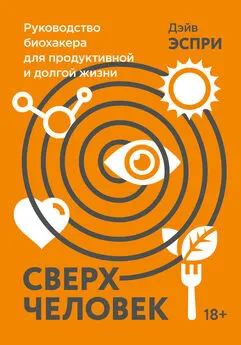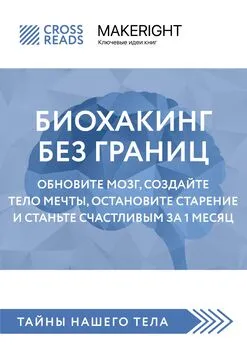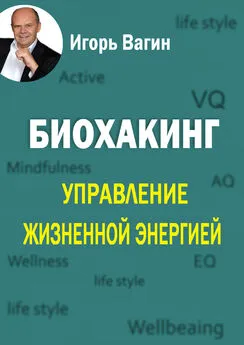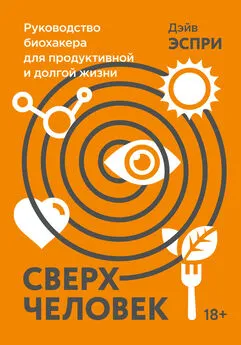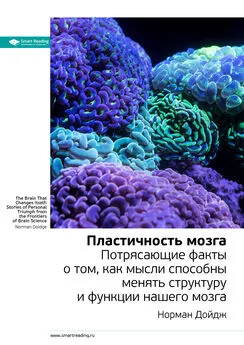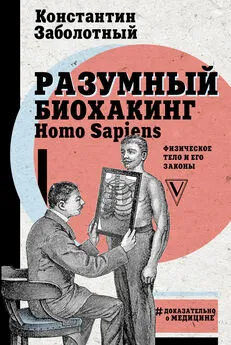Дэйв Эспри - Биохакинг мозга
- Название:Биохакинг мозга
- Автор:
- Жанр:
- Издательство:Манн, Иванов и Фербер
- Год:2018
- Город:Москва
- ISBN:9785001176312
- Рейтинг:
- Избранное:Добавить в избранное
-
Отзывы:
-
Ваша оценка:
Дэйв Эспри - Биохакинг мозга краткое содержание
Представили?
Это реально. В этой книге вы найдете эффективную программу прокачки организма. Вы узнаете, какие продукты должны присутствовать в вашем рационе и каких следует избегать, какие виды физической активности необходимо добавить в распорядок дня, как правильно организовать рабочее пространство, а еще о добавках, детоксе для дома и тела, медитации и дыхательных практиках, позволяющих мозгу всего за две недели заработать на все 100 %.
Биохакинг мозга - читать онлайн бесплатно ознакомительный отрывок
Интервал:
Закладка:
175
G. Bounous and P. Gold, “The Biological Activity of Undenatured Dietary Whey Proteins: Role of Glutathione,” Clinical and Investigative Medicine. Médecine Clinique et Experimentale 14, no. 4 (August 1991): 296–309.
176
Naila Rabbani and Paul J. Thornalley, “Dicarbonyls Linked to Damage in the Powerhouse: Glycation of Mitochondrial Proteins and Oxidative Stress,” Biochemical Society Transactions 36, Pt 5 (October 2008): 1045–1050, DOI: 10.1042/BST0361045.
177
Pamela Boon Li Pun and Michael P. Murphy, “Pathological Significance of Mitochondrial Glycation,” International Journal of Cell Biology 2012 (2012): 13, DOI: 10.1155/2012/843505.
178
Poonamjot Deol et al., “Soybean Oil Is More Obesogenic and Diabetogenic Than Coconut Oil and Fructose in Mouse: Potential Role for the Liver,” PLOS ONE 10, no. 7 (July 22, 2015): e0132672, DOI: 10.1371/journal.pone.0132672.
179
Bin Wu et al., “Dietary Corn Oil Promotes Colon Cancer by Inhibiting Mitochondria-Dependent Apoptosis in Azoxymethane-Treated Rats,” Experimental Biology and Medicine 229, no. 10 (November 2004): 1017–1025.
180
Hossam El-Din and M. Omar, “Mycotoxins-Induced Oxidative Stress and Disease,” in Mycotoxin and Food Safety in Developing Countries, ed. Hussaini Makun (InTech, 2013), http://www.intechopen.com/books/mycotoxin-and-food-safety-in-developing-countries/mycotoxins-induced-oxidative-stress-and-disease.
181
Peter F. Surai et al., “Mycotoxins and Animal Health: From Oxidative Stress to Gene Expression,” Krmiva 50, no. 1 (March 10, 2008): 35–43.
182
El-Din and Omar, “Mycotoxins-Induced Oxidative Stress and Disease.”
183
Kunio Doi and Koji Uetsuka, “Mechanisms of Mycotoxin-Induced Neurotoxicity Through Oxidative Stress-Associated Pathways,” International Journal of Molecular Sciences 12, no. 8 (August 15, 2011): 5213–5237, DOI: 10.3390/ijms12085213.
184
Elena A. Belyaeva et al., “Mitochondria as an Important Target in Heavy Metal Toxicity in Rat Hepatoma AS-30D Cells,” Toxicology and Applied Pharmacology 231, no. 1 (August 15, 2008): 34–42, DOI: 10.1016/j.taap.2008.03.017.
185
Elena A. Belyaeva et al., “Mitochondrial Electron Transport Chain in Heavy Metal-Induced Neurotoxicity: Effects of Cadmium, Mercury, and Copper,” Scientific World Journal 2012 (April 24, 2012), DOI: 10.1100/2012/136063.
186
S. Xu et al., “Cadmium Induced Drp1-Dependent Mitochondrial Fragmentation by Disturbing Calcium Homeostasis in Its Hepatotoxicity,” Cell Death and Disease 4, no. 3 (March 14, 2013): e540, DOI: 10.1038/cddis.2013.7.
187
C. B. Devi et al., “Developmental Lead Exposure Alters Mitochondrial Monoamine Oxidase and Synaptosomal Catecholamine Levels in Rat Brain,” International Journal of Developmental Neuroscience: The Official Journal of the International Society for Developmental Neuroscience 23, no. 4 (June 2005): 375–81, DOI: 10.1016/j.ijdevneu.2004.11.003.
188
A. M. Watrach, “Degeneration of Mitochondria in Lead Poisoning,” Journal of Ultrastructure Research 10, no. 3 (April 1, 1964): 177–181, DOI: 10.1016/S0022-5320(64)80001-0.
189
В 2016 году власти штата Мичиган сообщили, что у 200 детей был обнаружен повышенный уровень свинца в крови в связи с употреблением водопроводной воды в городе Флинте. Прим. ред.
190
James Dykens, “Drug-Induced Mitochondrial Dysfunction: An Emerging Model for Idiosyncratic Drug Toxicity” (Presentation, MitoAction teleconference, Online, 2009), http://www.mitoaction.org/files/Dykens%20for%20Mitoaction.pdf.
191
Sameer Kalghatgi et al., “Bactericidal Antibiotics Induce Mitochondrial Dysfunction and Oxidative Damage in Mammalian Cells,” Science Translational Medicine 5, no. 192 (July 3, 2013): 192ra85, DOI: 10.1126/scitranslmed.3006055.
192
Xu Wang et al., “Antibiotic Use and Abuse: A Threat to Mitochondria and Chloroplasts with Impact on Research, Health, and Environment,” BioEssays 37, no. 10 (2015): 1045–1053, DOI: 10.1002/bies.201500071.
193
J. L. Stauber and T. M. Florence, “A Comparative Study of Copper, Lead, Cadmium and Zinc in Human Sweat and Blood,” Science of the Total Environment 74 (August 1, 1988): 235–247, DOI: 10.1016/0048-9697(88)90140-4.
194
Stephen J. Genuis et al., “Blood, Urine, and Sweat (BUS) Study: Monitoring and Elimination of Bioaccumulated Toxic Elements,” Archives of Environmental Contamination and Toxicology 61, no. 2 (August 2011): 344–357, DOI: 10.1007/s00244-010-9611-5.
195
Damian Moran, Rowan Softley, and Eric J. Warrant, “The Energetic Cost of Vision and the Evolution of Eyeless Mexican Cavefih,” Science Advances 1, no. 8 (September 11, 2015): e1500363–e1500363, DOI: 10.1126/sciadv.1500363.
196
Martin Picard, “Mitochondrial Synapses: Intracellular Communication and Signal Integration,” Trends in Neurosciences 38, no. 8 (August 1, 2015): 468–474, DOI: 10.1016/j.tins.2015.06.001.
197
Bernard F. Godley et al., “Blue Light Induces Mitochondrial DNA Damage and Free Radical Production in Epithelial Cells,” Journal of Biological Chemistry 280, no. 22 (June 3, 2005): 21061–21066, DOI: 10.1074/jbc.M502194200.
198
Cora Roehlecke et al., “The Influence of Sublethal Blue Light Exposure on Human RPE Cells,” Molecular Vision 15 (2009): 1929–1938.
199
M. A. Mainster, “Light and Macular Degeneration: A Biophysical and Clinical Perspective,” Eye 1 (Pt 2) (1987): 304–310, DOI: 10.1038/eye.1987.49.
200
Tim Howard, “Colors: Why Isn’t the Sky Blue?” Podcast audio, Radiolab (WNYC, May 21, 2012), http://www.radiolab.org/story/211213-sky-isnt-blue/.
201
N. A. Rybnikova, A. Haim, and B. A. Portnov, “Does Artifiial Light-atNight Exposure Contribute to the Worldwide Obesity Pandemic?” International Journal of Obesity 40, no. 5 (May 2016): 815–823, DOI: 10.1038/ijo.2015.255.
202
Rosario Rizzuto, “The Collagen-Mitochondria Connection,” Nature Genetics 35, no. 4 (December 2003): 300–301, DOI: 10.1038/ng1203-300.
203
Martin Helan et al., “Hypoxia Enhances BDNF Secretion and Signaling in Pulmonary Artery Endothelial Cells” (Unpublished conference paper, American Society of Anesthesiologists, Anesthesiology Annual Meeting, Washington, DC, October 6, 2012), http://www.asaabstracts.com/strands/asaabstracts/abstract.htm?absnum=3709&index=9&year=2012.
204
Francesco L. Valentino et al., “Measurements and Trend Analysis of O 2, CO 2and delta 13C of CO 2from the High Altitude Research Station Jungfraujoch, Switzerland — a Comparison with the Observations from the Remote Site Puy de Dôme, France,” Science of the Total Environment 391, no. 2–3 (March 1, 2008): 203–210, DOI: 10.1016/j.scitotenv.2007.10.009C. Sirignano et al., “Atmospheric Oxygen and Carbon Dioxide Observations from Two European Coastal Stations 2000–2005: Continental Inflence, Trend Changes and APO Climatology,” Atmospheric Chemistry and Physics 10, no. 4 (February 15, 2010): 1599–1615, DOI: 10.5194/acp-10-1599-2010Y. Tohjima et al., “Gas-Chromatographic Measurements of the Atmospheric Oxygen/Nitrogen Ratio at Hateruma Island and Cape Ochi-Ishi, Japan,” Geophysical Research Letters 30, no. 12 (June 2003): 1653, DOI: 10.1029/2003GL017282.
205
C. A. Ramos, H. T. Wolterbeek, and S. M. Almeida, “Exposure to Indoor Air Pollutants during Physical Activity in Fitness Centers,” Building and Environment 82 (December 2014): 349–360, DOI: 10.1016/j.buildenv.2014.08.026.
206
Angel A. Zaninovich et al., “Mitochondrial Respiration in Muscle and Liver from Cold-Acclimated Hypothyroid Rats,” Journal of Applied Physiology 95, no. 4 (October 1, 2003): 1584–1590, DOI: 10.1152/japplphysiol.00363.2003.
207
Véronique Ouellet et al., “Brown Adipose Tissue Oxidative Metabolism Contributes to Energy Expenditure during Acute Cold Exposure in Humans,” Journal of Clinical Investigation 122, no. 2 (February 1, 2012): 545–552, DOI: 10.1172/JCI60433.
208
J. Leppäluoto et al., “Effects of Long-Term Whole-Body Cold Exposures on Plasma Concentrations of ACTH, Beta-Endorphin, Cortisol, Catecholamines and Cytokines in Healthy Females,” Scandinavian Journal of Clinical and Laboratory Investigation 68, no. 2 (2008): 145–153, DOI: 10.1080/00365510701516350.
209
Anna Lubkowska, Barbara Dołęgowska, and Zbigniew Szyguła, “Whole-Body Cryostimulation — Potential Benefiial Treatment for Improving Antioxidant Capacity in Healthy Men — Significance of the Number of Sessions,” PLOS ONE 7, no. 10 (October 15, 2012): e46352, DOI: 10.1371/journal.pone.0046352.
210
Hans-Rudolf Berthoud and Winfried L. Neuhuber, “Functional and Chemical Anatomy of the Afferent Vagal System,” Autonomic Neuroscience, Fever: The Role of the Vagus Nerve, 85, no. 1–3 (December 20, 2000): 1–17, DOI: 10.1016/S1566-0702(00)00215-0.
211
Karen L. Teff, “Visceral Nerves: Vagal and Sympathetic Innervation,” Journal of Parenteral and Enteral Nutrition 32, no. 5 (October 2008): 569–571, DOI: 10.1177/0148607108321705.
212
Lulu Xie et al., “Sleep Drives Metabolite Clearance from the Adult Brain,” Science 342, no. 6156 (October 18, 2013): 373–377, DOI: 10.1126/science.1241224.
213
Antoine Louveau et al., “Structural and Functional Features of Central Nervous System Lymphatic Vessels,” Nature 523, no. 7560 (July 16, 2015): 337–341, DOI: 10.1038/nature14432.
214
Cristina Carvalho et al., “Cerebrovascular and Mitochondrial Abnormalities in Alzheimer’s Disease: A Brief Overview,” Journal of Neural Transmission 123, no. 2 (January 2015): 107–111, DOI: 10.1007/s00702-015-1367-7.
215
Xie et al., “Sleep Drives Metabolite Clearance from the Adult Brain.”
216
Vaddanahally T. Maddaiah et al., “Effect of Growth Hormone on Mitochondrial Protein Synthesis,” Journal of Biological Chemistry 248, no. 12 (June 25, 1973): 4263–4268.
217
Guang Yang et al., “Sleep Promotes Branch-Specific Formation of Dendritic Spines after Learning,” Science 344, no. 6188 (June 6, 2014): 1173–1178, DOI: 10.1126/science.1249098.
218
Kristen L Knutson, “Impact of Sleep and Sleep Loss on Glucose Homeostasis and Appetite Regulation,” Sleep Medicine Clinics 2, no. 2 (June 2007): 187–197, DOI: 10.1016/j.jsmc.2007.03.004.
219
Laurent Brondel et al., “Acute Partial Sleep Deprivation Increases Food Intake in Healthy Men,” American Journal of Clinical Nutrition 91, no. 6 (June 2010): 1550–1559, DOI: 10.3945/ajcn.2009.28523.
Читать дальшеИнтервал:
Закладка:
